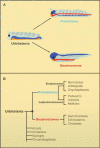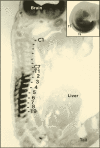Evo-devo: variations on ancestral themes
- PMID: 18243095
- PMCID: PMC2280037
- DOI: 10.1016/j.cell.2008.01.003
Evo-devo: variations on ancestral themes
Abstract
Most animals evolved from a common ancestor, Urbilateria, which already had in place the developmental genetic networks for shaping body plans. Comparative genomics has revealed rather unexpectedly that many of the genes present in bilaterian animal ancestors were lost by individual phyla during evolution. Reconstruction of the archetypal developmental genomic tool-kit present in Urbilateria will help to elucidate the contribution of gene loss and developmental constraints to the evolution of animal body plans.
Figures





References
-
- Aguinaldo AMA, Turbeville JM, Linford LS, Rivera MC, Garey JR, Raff RA, Lake JA. Evidence for a clade of nematodes, arthropods and other moulting animals. Nature. 1997;387:489–492. - PubMed
-
- Akiyama-Oda Y, Oda H. Axis specification in the spider embryo: dpp is required for radial-to-axial symmetry transformation and sog for ventral patterning. Development. 2006;133:2347–2357. - PubMed
-
- Appel TA. The Cuvier-Geoffroy Debate: French Biology in the Decades before Darwin. Oxford University Press; New York: 1987.
-
- Arendt D, Technau U, Wittbrodt J. Evolution of the bilaterian larval foregut. Nature. 2001;409:81–85. - PubMed
Publication types
MeSH terms
Substances
Grants and funding
LinkOut - more resources
Full Text Sources

